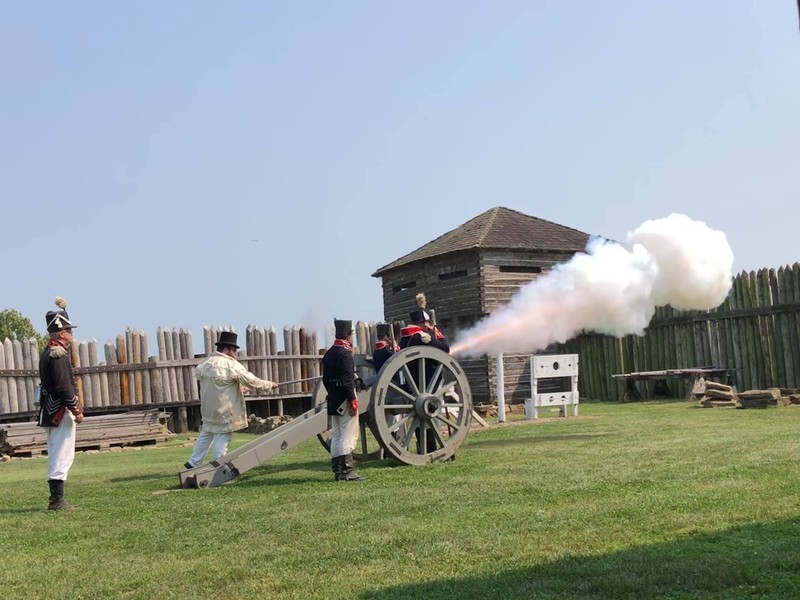Old Fort Madison
Introduction
Text-to-speech Audio
In 1808, the U.S. Army established Fort Madison to assert American influence of and conduct trade with the Indians living in the Upper Mississippi region. Old Fort Madison is a reconstruction of the fort and is located in Riverview Park just to the west of the fort's original location. It features several structures including soldiers barracks, blockhouses, and a palisade wall. There is also a working cannon in the center of the fort. Old Fort Madison is also a living history attraction. Visitors can interact with historical interpreters who are dressed soldier's uniforms and other types of period clothing. The soldiers perform musket fire demonstrations and the fort hosts special events such as a reenactment of the siege of September 1812. The original fort site is listed on the National Register of Historic Places.
Images
Old Fort Madison is a reconstruction of Fort Madison, which was located nearby and occupied from 1808 to 1813. Old Fort Madison explores the history of the fort through battle reenactments, cannon and musket fire demonstrations, and other activities.


Backstory and Context
Text-to-speech Audio
Fort Madison was part of a network of government trading houses that was known as the U.S. Factory System. The system was created in 1795 by the U.S. government and its purpose was to establish diplomatic and trading relations with Indians. The federal government designated "factors" at military posts who oversaw the trade. At the time, the U.S. was a young country and needed Indians as allies against European rivals, particularly Britain. Maintaining peace by forging economic ties with Indians was therefore an important goal for the U.S.
In 1804, Fort Madison was established under Article 9 of the Treaty of St. Louis, which was an agreement between the Sac and Fox Indians signed in 1804. The Sac and Fox agreed to cede their lands to the federal government in exchange for annual payments of $1,000 in goods and cash (it should be noted that many Sac and Fox argued that the chiefs who negotiated with the U.S. were not authorized to do so). The fort was originally located at Belle Fontaine near St. Louis but it was unpopular as it was too far from Indian villages. As a result the fort was moved here in 1808. In doing so, Fort Madison marked the beginning of the federal government's presence in the upper part of the Louisiana Purchase, which the U.S. acquired from France in 1803.
Fort Madison was the third highest grossing factory in the system between 1808 and 1811, grossing over $10,000 in those years. Some of the goods the Indians traded were furs (beaver, otter, muskrat, raccoon, rabbit, bobcat, wolf, deer, elk, and buffalo), lead, tallow, bees wax, and feathers. In exchange, they received blankets, clothing, pots and pans, knives, gun powder, jewelry, farming implements, and sewing materials.
The beginning of the end of Fort Madison began after the War of 1812 broke out between the U.S. and Britain and their corresponding Indian allies. In March 1812, Ho-Chunk warriors attacked the fort in retaliation for their losses at the 1811 Battle of Tippecanoe in Indiana. Two soldiers and around six warriors were killed in the attack. In September, around 160 Ho-Chunk warriors and around 40 Sac warriors attacked the fort as part of an offensive devised by Shawnee chief Tecumseh, who formed an Indian confederacy and opposed American expansion. The warriors sieged the fort for four days and the trading post was destroyed, which effectively ended trade. The fort was then used mainly as an intelligence gathering and defensive outpost. In July 1813, Ho-Chunk, Menominee, and Sac warriors attacked the fort twice during which six soldiers and around six warriors were killed. In November, the conditions at the fort were poor. The army contractor started to deliver rotten meat and moldy flour to the fort in the summer and by the fall there were only rotten pork and potatoes to eat. With winter approaching, the soldiers set fire to the fort and left for St. Louis. No fighting appears to have occurred at that time.
Sources
"Fort Madison and the U.S. Factory System." Old For Madison. Accessed November 14, 2021. https://www.oldfortmadison.org/learn/fort-madison-and-the-u-s-factory-system.
"Fort Madison's Role." Old Fort Madison. Accessed November 14, 2021. https://www.oldfortmadison.org/learn/fort-madisons-role.
"Fur Trade Factory System in Wisconsin." Wisconsin Historical Society. Accessed December 14, 2021. https://www.wisconsinhistory.org/Records/Article/CS2397.
"The United States Factory System." Fort Osage National Historic Landmark. Accessed November 14, 2021. https://fortosagenhs.com/history/us-factory-system.
Both images via Old Fort Madison
